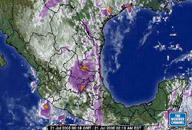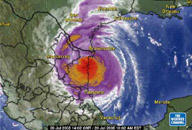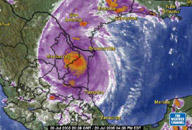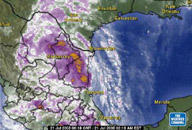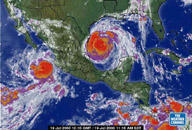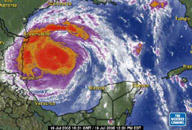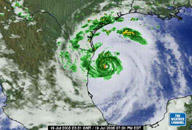Hypothetically
[NL]—Living abroad, especially in México, has given me a much more intricate view of the political boundary known as the border. At home, it was easy to think of the border in narrower terms than it is now. The border was ours; you know, American. On the other side, foreign nations went about their daily, foreign lives. To some, those nations represent a clandestine desire to cross that border and take up residency in the US, legally or otherwise, and the border is something primarily in need of control or defense. To others, México or Canada are places to escape or retire to, and the border is a gateway to home base. Still others concern themselves with products that might be imported over the border and then sold illegally. In the US, the border with México runs 1,951 miles along the southern edges of California, Arizona, New Mexico and Texas. Between México and Texas, the border is a partly muddy, partly dry half-baked river called the Rio Grande. This river is the busiest international border in the world.
But what the border now represents to me is a complicated and utterly necessary international line in the sand, replete with imponderable rules and regulations, international laws and confusion. It is owned by more than merely the US and México, and is used by nationals of many different countries. It is the source of custody disputes that are decided at the Hague, a critical market for multinational vendors, and a two-way trouble spot of bureaucratic documentation for anyone utilizing it in its capacity as a conduit. It is a swath of the best and worst of its two worlds, amalgamated and alchemized into a whole third world which can be confusing and familiar at one moment, and confused and overly familiar the next.
If I sound like I am complaining, I want to stress that I am not. As a US citizen, the border is mostly open to me. While it is difficult to get the type of visa I need to live here for two years—or to work, or to buy property—it has been very easy to get temporary ones that allow me to stay and travel. Plus, every time I cross that magical border again, these easy visas—really only tourist cards—are renewed. It is far more challenging for my counterparts to cross the river in the other direction, requiring vast documentation proving national ties, costing hundreds of dollars, and sometimes requiring US sponsorship. And if that weren’t enough, while the majority of the people I meet on this side of the border appreciate my business, interest, and presence; my counterparts might be met with paranoia, racism, and jingoism. These knee-jerk reactions in the US color the views of the physical border, and its users, for a far greater number of people than the radicals who write in the newspaper op-ed pages, rant on talk radio, and mobilize into a volunteer armies (who literally sit in state’s defense against the tide of illegal population daily threatening America’s terrestrial shores). Even moderate people might find themselves thinking in terms of the border as a doorway for an alien Them to use when desperate to make a new life, and We venture through to enrich the life we have. Reasonable people might conclude that the laws being broken at the border are primarily being broken by Them.
Living abroad can clear that attitude right up. In the expatriate community it is easy to come across the opposite type of story. Custody battles loom large, and it has become a very difficult paperwork hurdle for a single parent to bring a child across the border. Worse, foreign criminals have been known to kidnap, rob, or kill here. It is possible that kidnappers, robbers, and killers attempt occasionally to flee here, imagining that they might be safe outside of US jurisdiction (an idea so fundamentally wrongheaded that it takes but a few seconds of clear thought to see the lunacy in it). Runaways, joy riders, and underage drinkers cross the border regularly for an escape into the thrill of adventure. Interestingly, the unconscious misperception that the international border is somehow theirs, solely within the purview of the United States, adds to the possibility that perfectly innocent travelers might skip the small but legalizing step of actually getting proper documentation for the trip, adding to the problem. Others, hypothetically, are unable to get this documentation because they truly are entering the county illegally or for illicit reasons. Even the most innocent excursion, no harm intended, could represent both things.
A dad might take his son for a day trip into Mexico to see a relative, and do so without mom’s knowledge. A group of fourteen year olds could decide to take a road trip after school one afternoon to learn something about the world. It is very easy to enter México with benign intent and still be breaking the law. México doesn’t require much more than a driver’s license to visit border areas for a day or two. Tourist travel cards are required whenever a traveler ventures outside of México’s border zone, which extends approximately twenty-five kilometers into the interior, or stays for over three days. This assumes that other intents and purposes are legal. In the instances above, for personal reasons, people who don’t feel like they are doing anything morally wrong may still fail to do what is legally right, fearing exposure. In other instances, ignorance of the rules or how to go about actually following them, can be a culprit.
Ten years ago, I traveled all around México without the proper forms simply because I could not find the building in which I was supposed to get them. No one ever bothered to check until after midnight one night on a bus between Tulum and Veracruz, when armed men identified me as a traveler without legal documentation. I had not intended to do anything wrong; nor was I more than marginally aware that I had. I was not breaking any imperative laws. But I was, technically, an illegal alien.
Like many illegal aliens crossing into the US, most people traveling incorrectly in México are rarely identified, and are not considered too much of a threat to the nation, either. When they are caught, México seems to be overly gracious in handling them. Reading the newspaper, it is possible to find citations for travelers committing crimes and finding their way to Mexican prisons, or deportation back to home prisons. But the innocently guilty, like yours truly in Veracruz or these other standard, hypothetical lawbreakers (our runaways, for example), tend to be treated with kindness. At most they are asked nicely to leave. They can be detained in youth shelters until they are picked up by parents, or escorted back to their country of origin. In the case of teen runaways or thrill seekers, this means that they will be treated to a hot meal and some shelter after their money has run out. Runaways don’t tend to break many laws. Often, they are simply too young to be legal. Maybe they have traveled over the border with undeclared items, minor amounts of controlled substances, or pets that have not undergone quarantine. This might cause a little hitch in the friendly system México employs to deal with these kids. Now we are talking a little bit of extra crime, smuggling maybe, controlled substances; or perhaps merely the minor snag that the shelter just doesn’t allow pets. Our hypothetical runaways never thought of themselves as smugglers, surely; the pet was purely for personal use. In my own case, since I was not underage, carrying contraband, or otherwise illegal beyond the status of my travel papers, I was given the opportunity to belatedly obtain them several months into my trip. Our hypothetical runaways are in a little deeper. They must be supervised and then repatriated. The contraband pet must be quarantined or dealt with in some other way.
It is possible, then, to imagine that someone else might take the pet, if only to remove the obstacle. Maybe it is almost midnight, raining heavily, and the police are on their way. Whatever social worker, security agent, or Samaritan, seeing that the loved and un-quarantined animal presents a legal issue for México and the kids, a stumbling block to their shelter, and its own problem of repatriation, might take the pet temporarily until something can be worked out. This harmless act of kindness, to kid and animal nationals like, also falls on the other side of border legality. So, in this hypothetical way, the innocent fault can spread, accidentally turning more unsuspecting victims into international scofflaws. Plus, it is impossible to imagine that there will ever be a time when the pet and the kids would be able to be reunited, anyway. It is another wrongheaded idea cleared away with a little further speculation. The next day, or whenever the hurricane is over and the parents show up to drive the runaways home, the pet remains contraband. Smuggling back over the border would make it illegal in two countries. So, either the animal would have to permanently adopt the cover of Mexican pet, or expose the web of lies that its hypothetical presence outside of quarantine represents.
So, after so many stories and so much conjecture, I am getting to the point where the paranoia and suspicion I feel in regard to the border has nothing to do with those trying to use it for the usual illegal purposes of invasion or trafficking. Rather, I am concerned about what innocent lapse or overlooked detail will make me the next accidentally illegal alien abroad. In other news, today we finally found a permanent home for a sweet little gray Mexican kitten that we found on the street just before Hurricane Emily hit the Tamaulipas seaboard.
Click here to read the entire text of this post.
